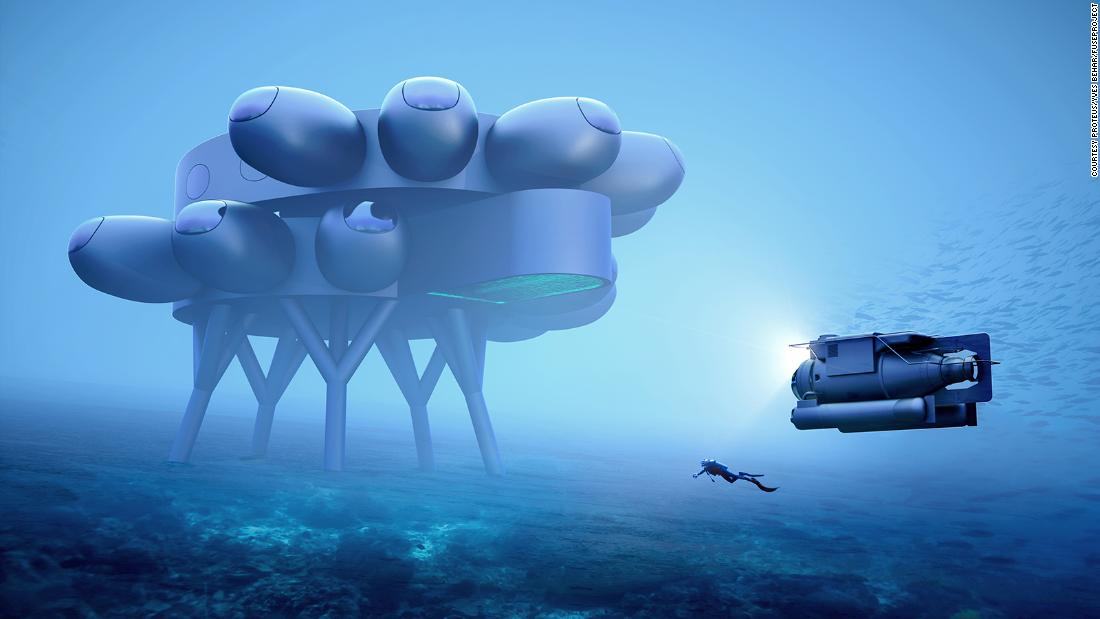
Sixty feet below the surface of the Caribbean Sea, aquanaut Fabien Cousteau and industrial designer Yves Béhar are imagining the station and the world’s largest underwater research habitat.
The couple have unveiled Fabien Cousteau’s Proteus, a 4,000-square-foot modular laboratory that will be located underwater off the coast of Curaçao, providing a home for scientists and researchers from around the world studying the ocean, from the effects of climate change. and new marine life to medicinal advances.
Designed as a two-story circular structure resting on the ocean floor on stilts, Proteus’ overhanging pods contain laboratories, personal quarters, medical bays, and a lunar pool where divers can access the ocean floor. Powered by wind and solar power, and ocean thermal energy conversion, the structure will also feature the world’s first underwater greenhouse for growing food, as well as a video production facility.

Proteus by Fabien Cousteau Credit: Courtesy of Proteus / Yves Béhar / Fuseproject
Proteus is intended to be the underwater version of the International Space Station (ISS), where government agencies, scientists and the private sector can collaborate in the spirit of collective knowledge, regardless of borders.
“Ocean exploration is 1,000 times more important than space exploration for, selfishly, our survival, for our journey into the future,” Cousteau said in a video call with Béhar. “It is our life support system. It is why we exist in the first place.”
The recently presented design is the last step for this ambitious project. According to Cousteau, it will take three years for Proteus to be installed, although the coronavirus pandemic has already delayed the project.

Yves Behar (left) and Fabien Cousteau (right) lead the Proteus project. Credit: Fuse Project / Clare Vonderhaar
Left undiscovered
Although the oceans cover 71 percent of the world’s surface, the National Oceanic and Atmospheric Administration (NOAA) estimates that humans have only explored about 5 percent and mapped less than 20 percent of the world’s seas.
Space exploration receives more attention and funding than its aquatic counterpart, which Cousteau hopes to remedy with Proteus, and eventually a worldwide network of underwater research habitats. Installations stationed in different oceans could warn of tsunamis and hurricanes, Cousteau said. They could also be pioneers in ambitious new research on sustainability, energy and robotics.
Underwater habitats allow scientists to make continuous dives day and night without requiring hours of decompression between dives. Like astronauts in space, they can stay underwater for days or weeks at a time.
Currently, the only underwater habitat that exists is the 400-square-foot Aquarium, in the Florida Keys, where Costeau stayed with a team of aquanauts for 31 days in 2014. Designed in 1986 and originally owned by NOAA, in 2013 Florida International University saved Aquarius from being abandoned after NOAA lost government funds.

Aquarium underwater research habitat in the Atlantic Ocean. Credit: Mark Conlin / VW PICS / UIG / Getty Images
Family tradition
Cousteau comes from a family of famous oceanographic explorers. He is the son of filmmaker Jean-Michel Cousteau and grandson of Aqua-Lung co-creator Jacques-Yves Cousteau. The project is a joint effort between the Fabien Cousteau Ocean Learning Center (FCOLC) and the design firm Béhar Fuseproject, as well as its partners, which include Northeastern University, Rutgers University and the Research and Management Foundation of the Caribbean biodiversity.
Despite his emphasis on ocean research, Cousteau said he is “a great advocate of space exploration,” noting that they are similar in nature. Both types of missions require humans to be isolated in extreme and unsustainable conditions. Because of that, the design of Béhar, which can hold up to 12 people, focuses on well-being, as well as scientific and technological capabilities, including recreation areas and windows designed to allow the entrance of the greatest amount of light. possible.
“We have recently worked in many small living environments. We have worked on robotic furniture for small apartments,” Béhar said of Fuseproject. “So I think we had a good idea of how to design for comfort in restricted environments. That said, the underwater environment is completely different.”
“We wanted it to be new, different, inspiring and futuristic,” he continued. “So (we look) at everything from science fiction to modular housing and Japanese pods (hotels).” The design also aims to echo ocean life, with its structure inspired by the shape of coral polyps.
Béhar and his team also studied the underwater research habitats that have come before Proteus, including the Aquarium. All other precursors were temporary structures built for individual missions, such as NASA’s experimental SEALAB I, II, and III of the 1960s.
“These habitats were specifically built, they were small and had great limitations,” said Cousteau. “So we are building from … (a) the base of all those incredible pioneers who preceded us.”

Proteus by Fabien Cousteau Credit: Courtesy of Proteus / Yves Béhar / Fuseproject
Dive ahead
While the project is currently supported by the private sector, it is currently seeking more funds. Beyond sponsors, the station’s wet and dry labs can be rented to government agencies, corporations, and academic institutions.
Part of the plan is to offer regular visibility into what’s going on in Proteus, including live streams and VR / AR content. In this way, Cousteau hopes to attract a broader audience.
“Imagine if you find something surprising, whether it’s microcosmic as a pharmaceutical, or macrocosmic as the next biggest animal, if you could show it in classrooms and universities,” he said.
“Our mission is to be able to translate complex science into something that the average person will not only understand, but fall in love with.”
.